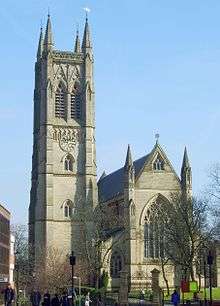Chequerbent railway station
| Chequerbent | |
|---|---|
| Location | |
| Place | Chequerbent, Westhoughton |
| Area | Bolton |
| Coordinates | 53°33′04″N 2°29′39″W / 53.5510°N 2.4943°WCoordinates: 53°33′04″N 2°29′39″W / 53.5510°N 2.4943°W |
| Grid reference | SD673061 |
| Operations | |
| Original company | London and North Western Railway |
| Pre-grouping | London and North Western Railway |
| Post-grouping | London, Midland and Scottish Railway |
| Platforms | 2[1][2] |
| History | |
| 2 February 1885 | Station opened |
| 3 March 1952 | Station closed to passengers[3] |
| 25 February 1965 | Station closed completely |
| Disused railway stations in the United Kingdom | |
|
Closed railway stations in Britain A B C D–F G H–J K–L M–O P–R S T–V W–Z | |
|
| |
| LNWR Lines to Bolton |
|---|
Legend |
Chequerbent railway station was in Westhoughton to the south-west of Bolton, Greater Manchester, on the line between Bolton Great Moor St and Kenyon Junction.
History
The Bolton and Leigh Railway (B&LR) opened for goods traffic in 1828, with passenger services following in 1831. The line included a number of steep inclines. Two of these were worked using ropes hauled by stationary engines, as opposed to locomotives used on the flatter sections.[4] To avoid these inclines and allow steam locomotives to haul trains for the entire journey, the London and North Western Railway (LNWR), successor to the B&LR, built deviations over easier gradients. This required the resiting of Daubhill and Chequerbent stations.
The station opened in 1885, replacing an earlier station which had opened in 1831. The new station was sometimes known as Chequerbent for Hulton Park.[3] The route of the new line passed under the A6, whereas the previous line had crossed at road level, so the new platforms were reached via two flights of steps.
The station closed to passengers in 1952, though local passenger trains continued to pass through for two more years and excursion traffic for four years after that. It finally closed completely in 1965.
Services
During the 1930s there were some 20 trains per day, but by the 1950s this had fallen to just six.
Freight traffic
The 1885 deviation eased the gradients somewhat, but the climb northwards from Atherton Bag Lane to Chequerbent remained arduous, with a nominal gradient of 1 in 30.5 for 1.6 miles - appreciably steeper than the Lickey Incline. This gradient was, however, purely nominal, as over the years colliery subsidence resulted in a continuous climb with an uneven gradient, including a stretch at 1 in 18.[5] This imposed severe restrictions on loads, locomotives and men[6] and resulted in this relative backwater becoming a Mecca for cameramen and film makers as dense loads such as sand were carried well into the 1960s.[7][8]
References
- ↑ Holland 2001, p. 36.
- ↑ Dart 2010, p. 20.
- 1 2 Butt 1995, p. 59.
- ↑ Awdry 1990, p. 62.
- ↑ Holland 2001, pp. 34 & 36
- ↑ Holland 2001, pp. 99–100.
- ↑ Holland 2001, pp. 36, 92 & 128.
- ↑ DVD 2003, 24 mins from start.
Sources
- Awdry, Christopher (1990). Encyclopaedia of British Railway Companies. Sparkford: Patrick Stephens Ltd. ISBN 1-8526-0049-7. OCLC 19514063.
- Butt, R. V. J. (1995). The Directory of Railway Stations: details every public and private passenger station, halt, platform and stopping place, past and present (1st ed.). Sparkford: Patrick Stephens Ltd. ISBN 1-8526-0508-1. OCLC 60251199.
- Dart, Maurice (2010). Images of Lancashire and Cheshire Railways: Classic Photographs from the Maurice Dart Railway Collection. Wellington, Somerset: Halsgrove. ISBN 978-0-85704-056-5.
- DVD (2003) [1959–65]. Lancashire & Yorkshire. Carnforth: Telerail. Steam World Archive Volume 4.
- Holland, Bert (2001). Plodder Lane for Farnworth. Leigh: Triangle Publishing. ISBN 0-9529333-6-5.
- Sweeney, Dennis J. (1996). A Lancashire Triangle Part One. Leigh: Triangle Publishing. ISBN 0-9529333-0-6.
External links
- The station via Disused Stations UK
- The station on a 1948 OS map via npe maps
- The station on an 1892 series OS map overlay via National Library of Scotland
- The station and line via Rail Map Online
- The station and line via railwaycodes
| Preceding station | Disused railways | Following station | ||
|---|---|---|---|---|
| Atherton Bag Lane Line and station closed |
London and North Western Railway | Rumworth and Daubhill Line and station closed | ||


